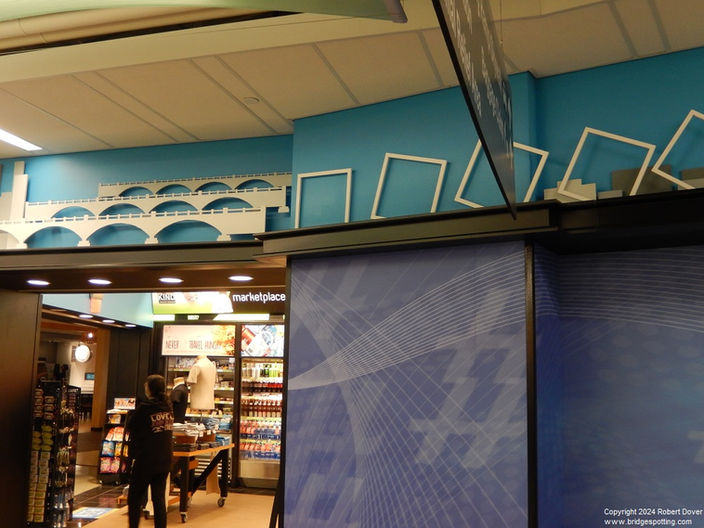Photographs of the Bridges
High Trestle Trail Bridge, Madrid, Iowa
One of the most famous lighted bridges in the entire United States is located in Iowa between the towns of Madrid and Woodward, approximately 30 miles northwest of Des Moines. The High Trestle Trail extends 25 miles from Ankeny to Woodward, and crosses the Des Moines River on a high bridge near the town of Madrid.
The feature that makes the High Trestle Trail Bridge a major attraction is not the bridge structure itself, but the sculptural artwork consisting of a series of steel squares through which the deck of the bridge passes. Each square is about ten feet long on each side, and each successive square is rotated a slight angle farther than the last. The squares represent the supports used to avoid cave-ins in coal mines, and the stylized streaks of brown stone on the large, cement entry towers on the four corners of the bridge represent coal deposits found within the local limestones. The deck has been expanded at intervals, providing viewing platforms with historic and informational plaques. There is also a convenient viewing platform set off to the side of the bridge on the western end which allows for a side view of the bridge’s piers and square sculptures.
When viewed along the axis through the squares, the effect is that of a spiral design, rotating as it becomes smaller and smaller before disappearing into the distance. In an odd way, the design is not just a static sculpture but is kinetic. A kinetic sculpture has movement, usually achieved through moving pieces of the sculpture. In the case of the High Trestle Bridge, the movement is not supplied by the sculpture itself. Instead, the sculpture is intended to be viewed from the viewpoint of a bicycle rider, and it is the bicycle that supplies the movement by moving the observer of the sculpture instead of parts of the sculpture. The effect is that the spiral unwinds in front of you as you proceed and, of course, it is more intense the faster you ride. While the kinetic sculptural effect is interesting, it would likely not attract casual visitors other than cyclists, except for its most amazing feature: after dark, the squares along a lengthy segment of the bridge come alive, outlined in blue neon lights. The resulting image of the bright blue spiral design has turned an interesting bike ride into a statewide, and even nationwide, tourist attraction. The spirals are rusty reddish-brown during the daytime, then an attractive mix of rust red outlined in neon blue at dusk, and then fully blue at night. This is probably the only bike trail that specifically attracts riders at night.
The image has become so iconic that it is now a local, and even statewide, symbol, similar to how the New River Gorge Bridge has become a symbol of the state of West Virginia. If you drive to Madrid from Des Moines, your first hint that you are approaching the vicinity of the bridge comes when driving into Madrid on State Route 17. The large “Welcome to Madrid” sign is constructed of rust red steel girders, and the words are displayed against a background of a spiral series of rotating rust red squares. The road crosses the bike trail just before entering downtown, and there is a trailhead parking lot on the east side of Route 17. You may have to do a double take before you realize that the bike racks at the trailhead, and also those at the bridge itself, are in the form of rust red steel squares, each one rotated a bit farther than the next.
I have provided a much more detailed description of the bridge, its sculpture, and the use of images of the sculpture to attract tourists to visit this part of central Iowa, in Chapter 5 of my book Bridgespotting Part 2: A Guide to Even More Bridges that Connect People, Places, and Times.













